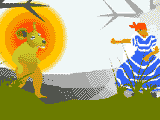New Media, New Narrative
New Media, New Narrative (2001)
John Cabral, Mouchette, and Mumbleboy
|
| New Media, New NarrativeJohn Cabral is a game designer who creates animated environments with characters that pull a 24-hour shift. Mouchette is a 12-year-old from Amsterdam, engaging her fans in an international call-and-response centered on mortality. Mumbleboy is a master of montage in the animated short, his euphoric segues reeling with the synergy of a fever dream. The work of these artists may seem whimsical but there is nothing left to chance about its formal tactics. All three artists share a concern with time-based structure, and to varying degrees, storytelling.Following this introduction is an interview with each artist conducted via e-mail in June 2001, as well as links to selected works.The greatest congruence between the works of these artists is in their immediacy. Although the worlds these artists create are time-based, and therefore rooted in the structure and history of the dramatic and musical arts, there is a painterly sense about them in their ability to be apprehended immediately on a surface level. This hybrid quality — the capacity of the works to be read at various temporal depths — is what makes them so flexible and powerful within the online environment. The immediacy of these works and the speed with which their underlying models can be apprehended is also central to their ability to sustain multiple viewings. This enables users to make successive investments in deeper layers, with the initial layer being the lynchpin.Despite their unique strategies, all three artists have fine-tuned their respective narrative engines for maximum speed. This is not merely a matter of small file sizes and fast downloads, but also a factor of the degree to which the works communicate their underlying conceptual models within a matter of seconds. In other words, one is immersed within their narrative construct by the time the first page of content has finished loading. This is where many instances of new media narrative fall short, in that they assume a level of immersion on the part of the user that is undeserved. For those who’ve ever walked out of a movie, you probably gave the film at least thirty minutes before leaving the theater. Within the context of new media, to say that this grace period has been compressed to thirty seconds would be a liberal estimate.John CabralIn informal conversations with John Cabral, he’s referred to the plot of “Ground Zero” as being mundane. I’d like to be able to argue with him about this, but have the handicap of never having seen the entire piece. Why would I write about a work that I haven’t seen in its entirety? The punch line is that in order to experience all of “Ground Zero,” one would have to watch the comings and goings of its characters for no less than 24 hours. The good news (for those who don’t expect to have such a large block of time available) is that through repeated visits, the project tells a story through an accretion of events. To this end, Cabral’s strategy is straightforward but relentless: map an animated story to the actual hours, minutes, and seconds of an entire day and night, and then repeat ad nauseam.In a gesture that brings to mind Andy Warhol’s “Empire,” Cabral’s vision takes on a sublime quality via the absurdity of its scale. Also bearing a relationship to the popular game entitled “The Sims,” “Ground Zero” makes visible the real-time, interactive apparatus slowly wrapping itself around us like a cybernetic python. Before dismissing this as a conspiratorial rant, consider the boom of reality-based television, as well as the recent appearance of both immersive gaming and immersive promotions (immersive meaning that the enterprise offers a level of personalized interaction that manifests itself in as many media channels as it can reach you in). For example, a friend recently told me that he started receiving phone calls at home after having opted into a promotion for the release of an upcoming film.The world of online gaming is flourishing with the most successful titles (EverQuest, Ultima Online, and Sim City) drawing tens of thousands of users to participate at any given time of day or night. Meanwhile, in Cabral’s “Ground Zero,” a story is mapped to a real-time clock, with the clock actually becoming a central character in the story. Ultimately, it doesn’t matter whether we see the story’s villainous hunter (Fatso) shoot Ratzo (the rat/protagonist) or whether we meet the otherworldly Voodoo Queen in the darkness of the night. Instead, what matters is the authenticity of Cabral’s model. He has created a world in which we can find realism in the omnipotence of the clock. It doesn’t matter so much “what” is happening as it does “when.” Regardless of whether the plot is mundane, the narrative of “Ground Zero” is endless and contains a structure prefiguring things on the horizon.
Mouchette
If Cabral’s question is “When?,” then Mouchette’s mantra would be “Who?.” Named after the main character of a Bresson film of the same name, Mouchette (“little fly” in French) has been buzzing around the Web for well over three years now without seeming to age a bit. Perhaps she has just been so busy making new work that she has not had time to update the HTML on her homepage listing her current age as “nearly 13 years old.” I’m sure that if dear, overworked Mouchette had a nickel for every e-mail she’s received inquiring as to whether she might be lying about her age, she would be able to treat us all to an evening of fun at an amusement park (something her namesake does in the film). In any case, visitors to her site are likely to feel giddy just the same. She’ll make you giggle and cringe and if you’re the type who gets easily spooked, you might want to have a friend hold your hand along the way.Mouchette is as relentless as Cabral in the singularity of her line of questioning, one revolving around identity and authorship. Seducing her audience with entrance into the secret world of a young girl, Mouchette traps visitors like flies in a web of questions about online identity. While we’re deluged with sensational stories related to the use of false identities online, Mouchette makes her home there addressing the issue with an air of humanism and humor that puts the nightly news to shame. Depending upon the depth of their belief in Mouchette, visitors enter this role-playing game from different angles before being led down a myriad of equally engaging paths. As with any good literature, the story becomes so fully realized within our imagination that additional information would only detract from it.I find the character of Mouchette recreated anew for me with each visit. As I learn more about her and spend more time pondering her character(s), the site begins to feel haunted like a room whose contents you’ve imagined, but never seen by the light of day. Users are invited to participate in this morbid drama when asked for opinions concerning deceased animals once held dear by Mouchette or for help with the details of a possible suicide by the artist. The intimacy of these exchanges is palpable and reflects the apotheosis of a continuum running from film through the medium of video and finally into new media. With each leap in technology, there is an increased level of intimacy between viewer and medium. Film is epic, video is narcissistic, and new media can be downright spooky.
Mumbleboy Part animation, part free-association, and part alien transmission, Mumbleboy’s work has been thrilling and confounding his audience for years. When asked about narrative, he was hesitant to apply this term to his work. However, it’s exactly this ambiguity towards storytelling and his occasional flirtation with it that makes Mumbleboy’s work so fascinating from a narrative standpoint. While most of his sequences are less than five minutes in length and feature seemingly random segues from one (often striking) illustration to another, there are reoccurring themes within his works. Mumbleboy’s animations offer us an alternative vision of what narrative might be within the multi-tasking, meta-environment of the Web. One can even read his works as distorted reflections of Web browsing sessions, with chance, irony, and humor all making cameo appearances.Mumbleboy’s signature technique is a fluid and bizarre style of digital montage. To watch his animations is to be inside a food processor calibrated to lyrically synthesize the contents of his visual cortex. Mumbleboy’s animations reflect the surface of a reality where “ordinary” characters are juxtaposed with those from pop culture in a way reminiscent of the visual delirium of Times Square. From a formal standpoint, the whimsical structure of his works and their experimental narratives are strengthened by his commitment to a flattened, two-dimensional world. These conditions provide a wealth of geometric raw material that can be liquefied and morphed by the hand of this master animator and suggest a critical position that sees flatness as realism.I’ve heard a few artists make interesting comments about the subject of flatness and realism over the last couple of years. The first was by painter and theorist, Peter Halley. In a lecture given at the Massachusetts College of Art in the late 1990s, he suggested that the urban spaces we inhabit are actually two-dimensional. His comments have stayed with me and consistently rung as true in a way that I’m incapable of explaining to a degree that would do them justice. The other instance where the congruence of flatness and realism was suggested to me was in a conversation with none other than John Cabral. Here he asserted that the realism of “The Simpsons” was heightened, if not enabled by their existence in two dimensions. I can only hope that someday Halley will write about an episode that finds Homer crossing over into a “Tron-like” world of 3D wireframe models and endlessly receding grids. |






